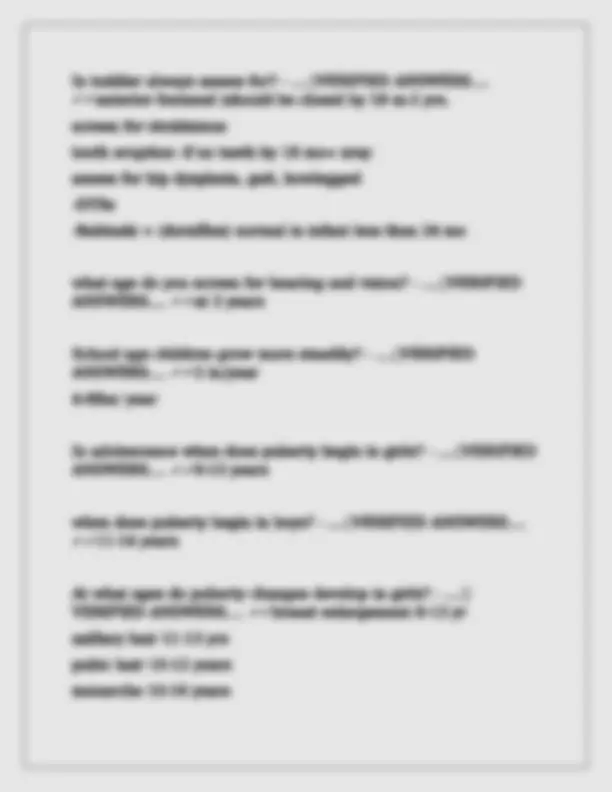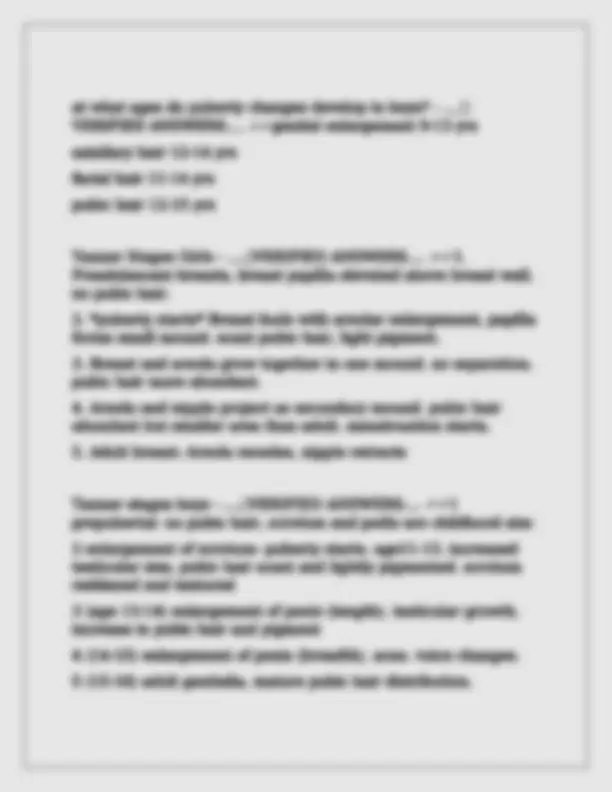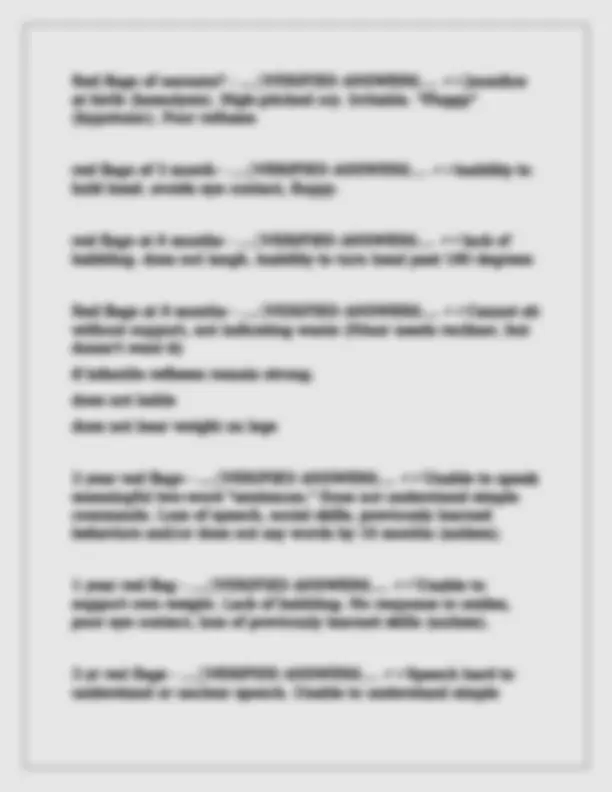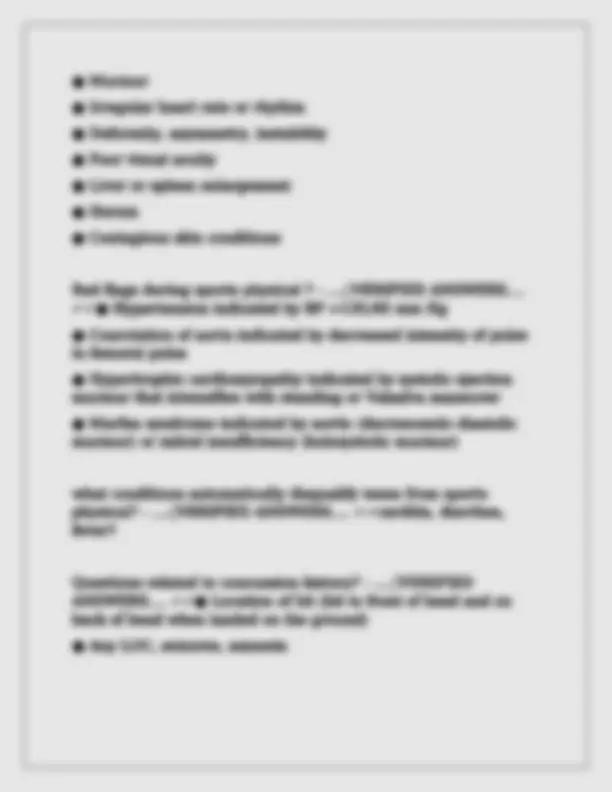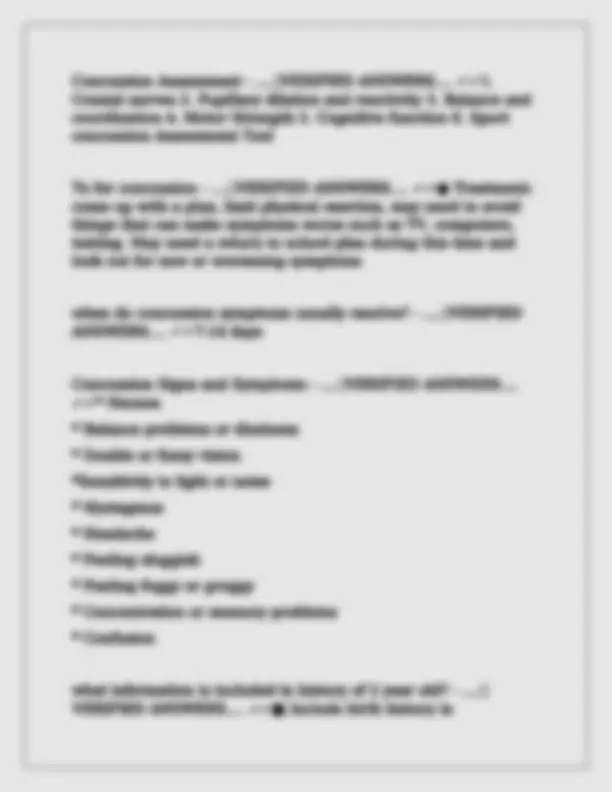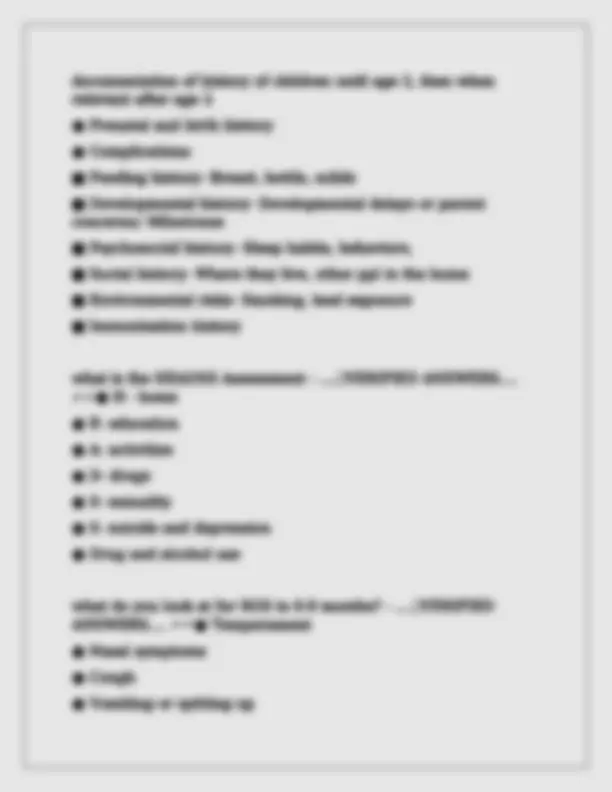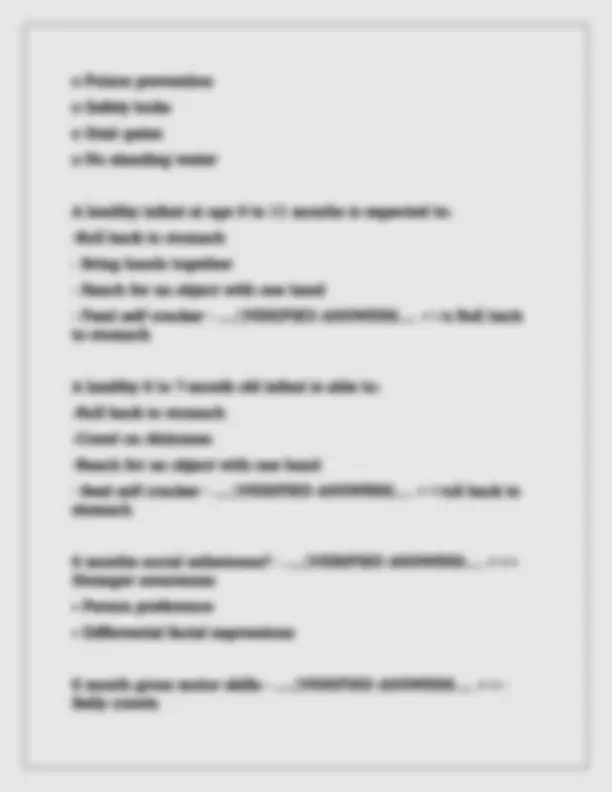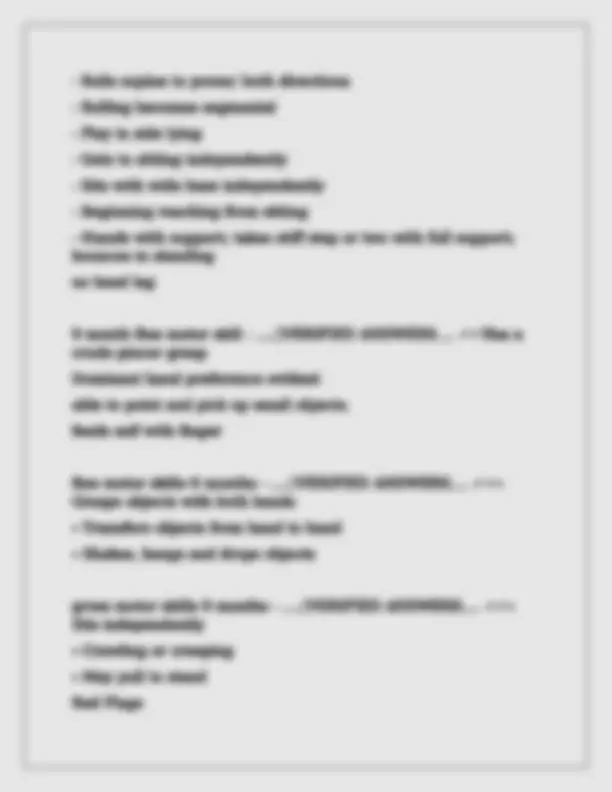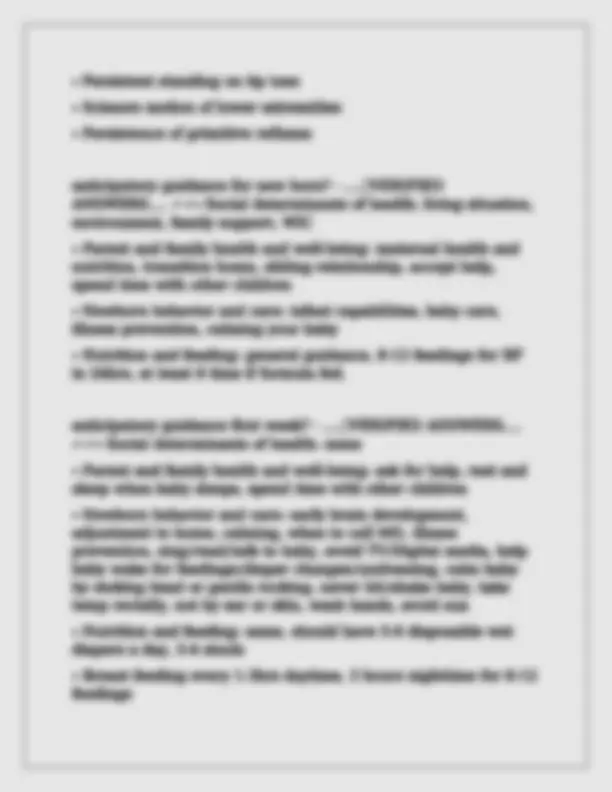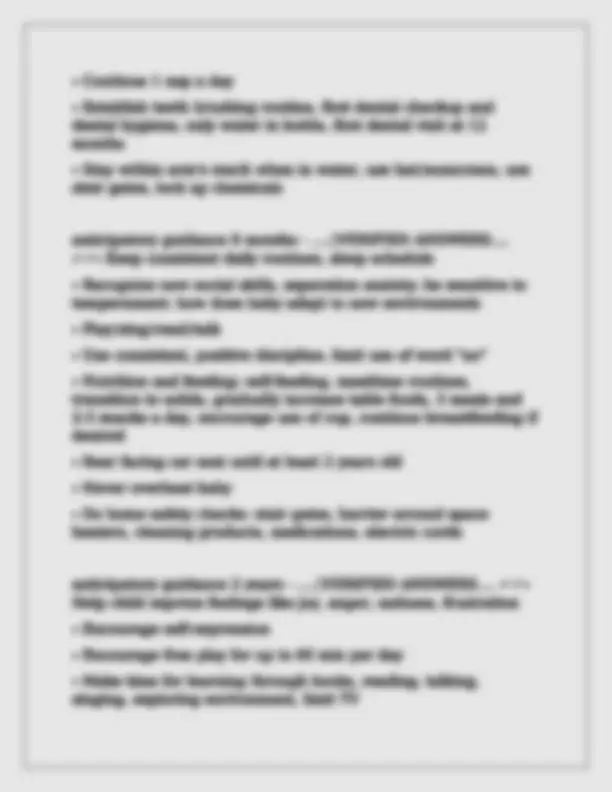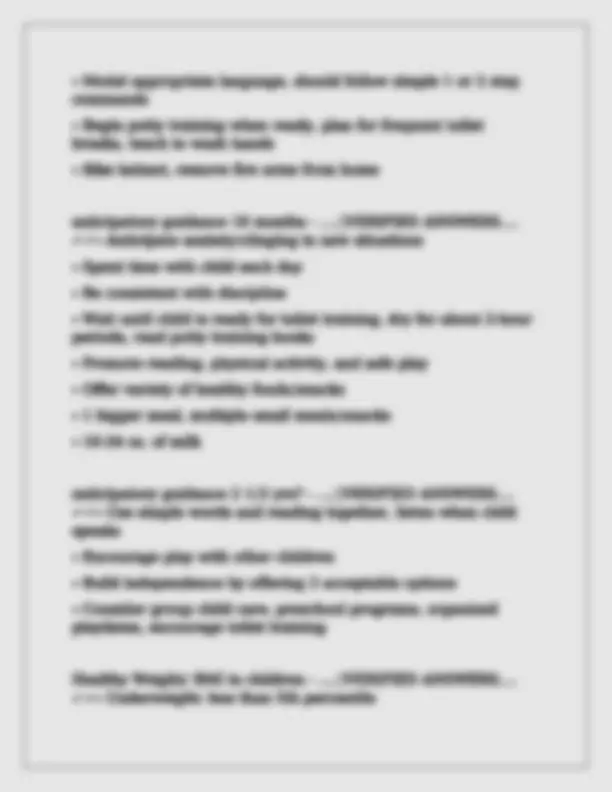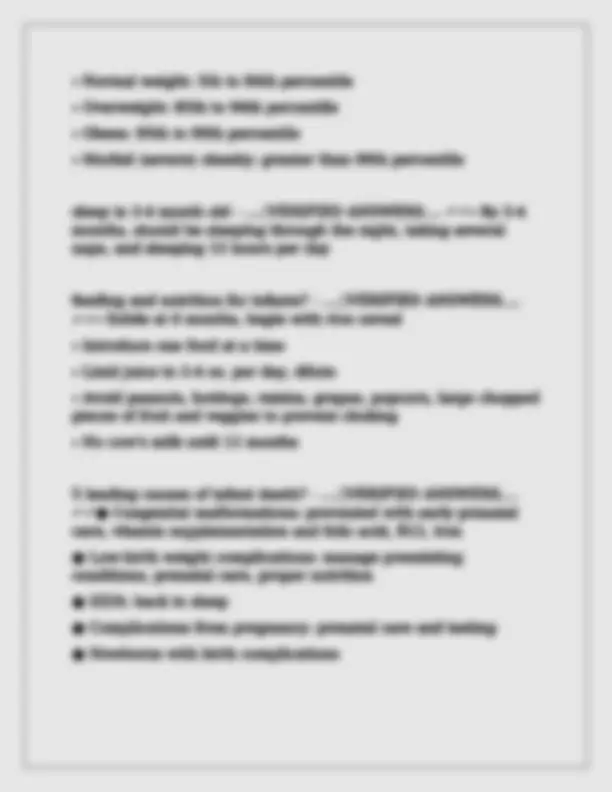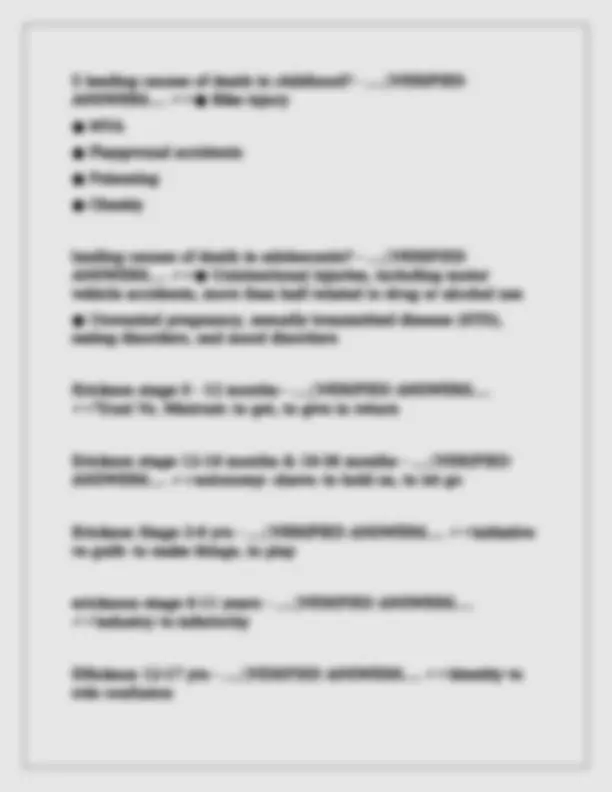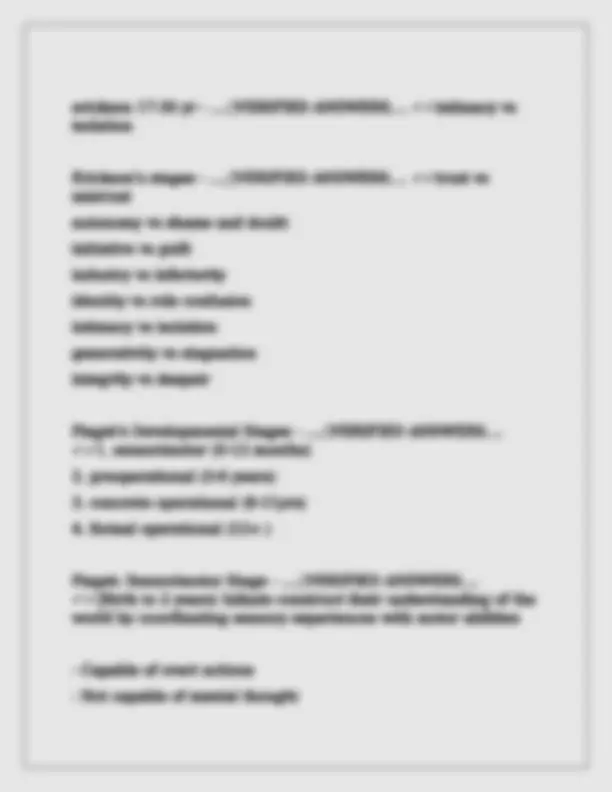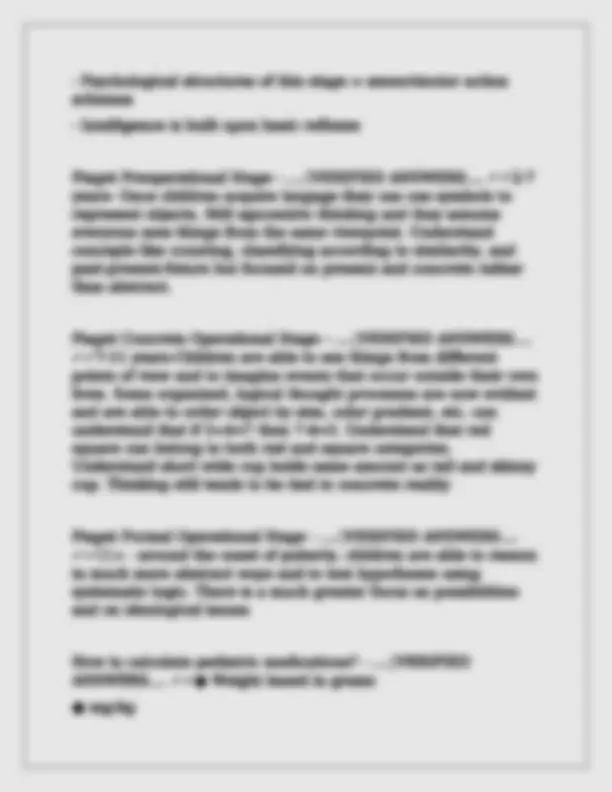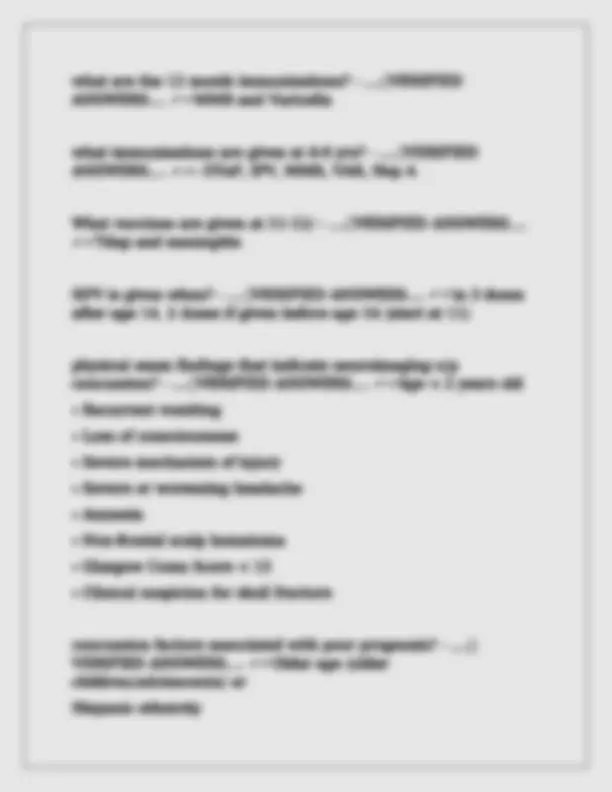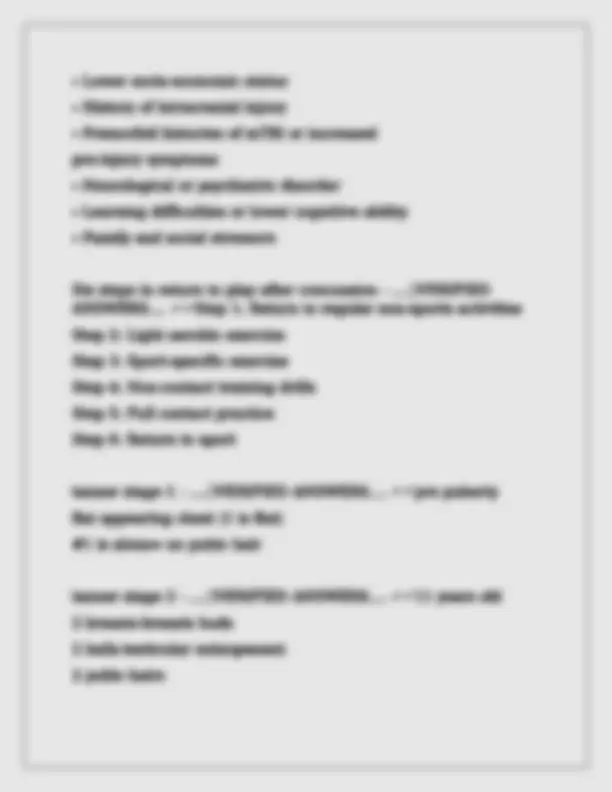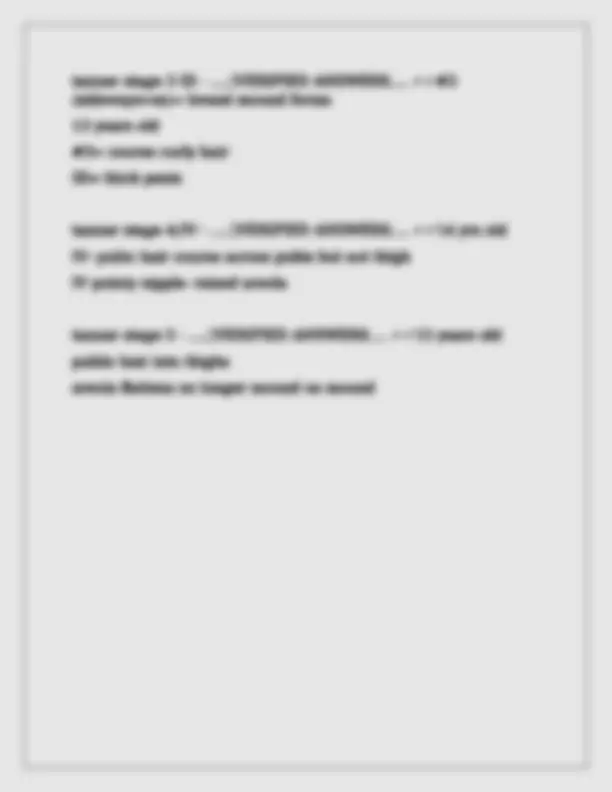Download NURS 629 Exam 2: Child Development and Physical Assessment and more Exams Nursing in PDF only on Docsity!
NURS 629 exam 2 questions with answers
Weight changes in 1st year of life - .... 🔰 VERIFIED ANSWERS.... ✔✔ Weight increases 6-8lbs, up to 20lbs in the 1st year of life When does the posterior fontanelle close? Anterior? - .... 🔰 VERIFIED ANSWERS.... ✔✔ posterior- 2 months, anterior- 9-18 mo when do the abdominal muscles close? - .... 🔰 VERIFIED ANSWERS.... ✔✔ 3 years When are the testicles descended? - .... 🔰 VERIFIED ANSWERS.... ✔✔ usually descended at birth, but spontaneous descent may occur in the first year after birth. (usually 6 months) what do you assess for with infants musculoskeletal system?
- .... 🔰 VERIFIED ANSWERS.... ✔✔ leg fold symmetry hib abduction- no clicks Ortolani maneuver - .... 🔰 VERIFIED ANSWERS.... ✔✔ check hips for congenital dislocation, done until 1 yr old, should be smooth with no sounds , abnormal= feels like a clunk as head of femur pops back into place- positive ortolani sign
Barlow maneuver - .... 🔰 VERIFIED ANSWERS.... ✔✔ place your index and middle finger over the greater tronchanter. Gently push both knees together at midline downwards. Positive:"Clunk" sounds or palpating trochangter being displaced by the index/middle finger Infantile eczema - .... 🔰 VERIFIED ANSWERS.... ✔✔ atopic dermatitis is an inflammation of genetically hypersensitive skin
- local vasodilation in affected areas spongiosis or breakdown of dermal cells and formation of intradermal vesicles
- rarely seen in breastfed infants until they begin to eat additional food
- it is a symptom rather than a disorder
- infant is oversensitive to certain substances Worse in winter why is acid reflux common in infants? - .... 🔰 VERIFIED ANSWERS.... ✔✔ their sphincters are not mature, break up feedings ~15mL, burp, then return. When does colic usually resolve? - .... 🔰 VERIFIED ANSWERS.... ✔✔ by 6 months Toddler weight gain per year - .... 🔰 VERIFIED ANSWERS.... ✔✔ 4- 6lbs per year, grow 3 inches pe ryear
at what ages do puberty changes develop in boys? - .... 🔰 VERIFIED ANSWERS.... ✔✔ genital enlargement 9-13 yrs axiallary hair 12-14 yrs facial hair 11-14 yrs pubic hair 12-15 yrs Tanner Stages Girls - .... 🔰 VERIFIED ANSWERS.... ✔✔ 1. Preadolescent breasts, breast papilla elevated above breast wall. no pubic hair.
- puberty starts Breast buds with areolar enlargement, papilla forms small mound. scant pubic hair, light pigment.
- Breast and areola grow together in one mound. no separation. pubic hair more abundant.
- Areola and nipple project as secondary mound. pubic hair abundant but smaller area than adult. menstruation starts.
- Adult breast: Areola recedes, nipple retracts Tanner stages boys - .... 🔰 VERIFIED ANSWERS.... ✔✔ 1 prepubertal- no pubic hair, scrotum and pedis are childhood size 2 enlargement of scrotum- puberty starts. age11-13. increased testicular size, pubic hair scant and lightly pigmented. scrotum reddened and textured 3 (age 13-14) enlargement of penis (length). testicular growth. increase in pubic hair and pigment 4 (14-15) enlargement of penis (breadth). acne. voice changes. 5 (15-16) adult genitalia, mature pubic hair distribution.
Red flags of neonate? - .... 🔰 VERIFIED ANSWERS.... ✔✔ Jaundice at birth (hemolysis). High-pitched cry. Irritable. "Floppy" (hypotonic). Poor reflexes red flags of 3 month - .... 🔰 VERIFIED ANSWERS.... ✔✔ inability to hold head. avoids eye contact, floppy. red flags at 6 months - .... 🔰 VERIFIED ANSWERS.... ✔✔ lack of babbling. does not laugh. inability to turn head past 180 degrees Red flags at 9 months - .... 🔰 VERIFIED ANSWERS.... ✔✔ Cannot sit without support, not indicating wants (Niner needs recliner, but doesn't want it) if infantile reflexes remain strong. does not bable does not bear weight on legs 2 year red flags - .... 🔰 VERIFIED ANSWERS.... ✔✔ Unable to speak meaningful two-word "sentences." Does not understand simple commands. Loss of speech, social skills, previously learned behaviors and/or does not say words by 16 months (autism). 1 year red flag - .... 🔰 VERIFIED ANSWERS.... ✔✔ Unable to support own weight. Lack of babbling. No response to smiles, poor eye contact, loss of previously learned skills (autism). 3 yr red flags - .... 🔰 VERIFIED ANSWERS.... ✔✔ Speech hard to understand or unclear speech. Unable to understand simple
■ Cardiac anomalies, murmurs, high blood pressure, irregular heart rate
- family cardiac history
- displaced PMI with different positioning
- changes in heart sounds with supine, standing and valsalva -asymmetric pulses contraindications for clearance from sports physical? - .... 🔰 VERIFIED ANSWERS.... ✔✔ ● Chest pains while exercising, congenital cardiac anomalies, hypertrophic cardiomyopathy, new murmurs, hypertension ● Family hx. Of sudden death under 50 or while playing sports, exertional syncope, symptoms of Marfan syndrome ● Marfan syndrome (2 or more of the following needs further evaluation: arm span longer than height, girls taller than 5. and boys taller than 6.0, kyphoscoliosis, pectus excavatum, myopia) who needs referral for f/u before clearance from sports physical?
- .... 🔰 VERIFIED ANSWERS.... ✔✔ ● History of or current cardiac anomalies ● Family cardiac history (cardiomyopathies, prolonged QT, Marfan syndrome, significant dysrhythmias, cardiac death in 1st or 2nd degree relative before age 40, connective tissue disorders) ● History of or current concussions ● History of or current injuries ● Hernia ● Hypertension
● Murmur ● Irregular heart rate or rhythm ● Deformity, asymmetry, instability ● Poor visual acuity ● Liver or spleen enlargement ● Hernia ● Contagious skin conditions Red flags during sports physical? - .... 🔰 VERIFIED ANSWERS.... ✔✔ ● Hypertension indicated by BP >135/85 mm Hg ● Coarctation of aorta indicated by decreased intensity of pulse in femoral pulse ● Hypertrophic cardiomyopathy indicated by systolic ejection murmur that intensifies with standing or Valsalva maneuver ● Marfan syndrome indicated by aortic (decrescendo diastolic murmur) or mitral insufficiency (holosystolic murmur) what conditions automatically disqualify teens from sports physical? - .... 🔰 VERIFIED ANSWERS.... ✔✔ carditis, diarrhea, fever? Questions related to concussion history? - .... 🔰 VERIFIED ANSWERS.... ✔✔ ● Location of hit (hit to front of head and on back of head when landed on the ground) ● Any LOC, seizures, amnesia
documentation of history of children until age 2, then when relevant after age 2 ● Prenatal and birth history ● Complications ■ Feeding history- Breast, bottle, solids ■ Developmental history- Developmental delays or parent concerns/ Milestones ■ Psychosocial history- Sleep habits, behaviors, ■ Social history- Where they live, other ppl in the home ■ Environmental risks- Smoking, lead exposure ■ Immunization history what is the HEADSS Assessment - .... 🔰 VERIFIED ANSWERS.... ✔✔ ● H - home ● E- education ● A- activities ● D- drugs ● S- sexuality ● S- suicide and depression ● Drug and alcohol use what do you look at for ROS in 6-9 months? - .... 🔰 VERIFIED ANSWERS.... ✔✔ ● Temperament ● Nasal symptoms ● Cough ● Vomiting or spitting up
● Frequency & consistency of stools ● Number of wet diapers ● Use of extremities - equal? ● Rashes ● Immunizations ROS in toddlers? - .... 🔰 VERIFIED ANSWERS.... ✔✔ ● Temperament ● Frequency & consistency of stools ● Number of wet diapers ● Immunizations ● Lead exposure ● Nutrition ● Sleeping and eating patterns at what age do you stop measuring head circumference? - .... 🔰 VERIFIED ANSWERS.... ✔✔ 2 years at what age is a BP check started? - .... 🔰 VERIFIED ANSWERS.... ✔✔ 3 yrs well child screenings - .... 🔰 VERIFIED ANSWERS.... ✔✔ ■ Blood pressure, height, weight, BMI, ocular motility, red reflex, pupil reaction, visual acuity, gums and teeth, café o le spots, bruising, birthmarks, nevi
o Poison prevention o Safety locks o Stair gates o No standing water A healthy infant at age 9 to 11 months is expected to: -Roll back to stomach
- Bring hands together
- Reach for an object with one hand
- Feed self cracker - .... 🔰 VERIFIED ANSWERS.... ✔✔ x Roll back to stomach A healthy 6 to 7-month old infant is able to: -Roll back to stomach -Crawl on Abdomen -Reach for an object with one hand
- feed self cracker - .... 🔰 VERIFIED ANSWERS.... ✔✔ roll back to stomach 6 months social milestones? - .... 🔰 VERIFIED ANSWERS.... ✔✔ • Stranger awareness
- Person preference
- Differential facial expressions 6 month gross motor skills - .... 🔰 VERIFIED ANSWERS.... ✔✔ - Belly crawls
- Rolls supine to prone/ both directions
- Rolling becomes segmental
- Play in side lying
- Gets to sitting independently
- Sits with wide base independently
- Beginning reaching from sitting
- Stands with support; takes stiff step or two with full support; bounces in standing no head lag 9 month fine motor skill - .... 🔰 VERIFIED ANSWERS.... ✔✔ Has a crude pincer grasp Dominant hand preference evident able to point and pick up small objects. feeds self with finger fine motor skills 6 months - .... 🔰 VERIFIED ANSWERS.... ✔✔ • Grasps objects with both hands
- Transfers objects from hand to hand
- Shakes, bangs and drops objects gross motor skills 9 months - .... 🔰 VERIFIED ANSWERS.... ✔✔ • Sits independently
- Crawling or creeping
- May pull to stand Red Flags
- Formula feed 2 oz. every 2-3 hours
- Safety: car seat safety, heat stroke prevention, safe sleep, rear facing car seat anticipatory guidance 1 month - .... 🔰 VERIFIED ANSWERS.... ✔✔ • Social determinants: risks, environment, mold, no tobacco use
- Parent and family health and well-being: postpartum checkup, maternal depression, family relationship
- Infant behavior and development: sleeping, waking, fussiness, playtime, consider pacifier, no TV, do tummy time, calm baby by rocking or stoking head
- Nutrition and feeding: same as 1st week
- Safety: same anticipatory guidance 2 month - .... 🔰 VERIFIED ANSWERS.... ✔✔ • Social determinants of health: risks, community agency, WIC, take time to self
- Post-partum checks, depression, anxiety
- Infant behavior and development: hold, cuddle, talk, sing to, learn baby's temperament, pay attention to sleeping cues, feeding cues, tummy time, avoid TV
- Nutrition and feeding: general guidance, first 6 months of life BF exclusively for ideal nutrition, same stool and wet diaper amounts
- Safety: care seat safety, sleep safety, home environment: burns, drowning, falls anticipatory guidance 4 months - .... 🔰 VERIFIED ANSWERS.... ✔✔ • Social determinants of health: reduce lead exposure,
maintain social contacts, make time for self, make quality child care arrangements
- Behavior and development: continue calming strategies, talk/play/sing to baby, create daily routine for feedings/naps/bedtime
- Oral health: clean pacifier and teething ring, don't put baby in crib with bottle, clean teeth and gums 2 xs a day with fluoride toothpaste, no more than grain of rice size
- Nutrition and feeding: delay solids until 6 months
- 30-32oz of formula anticipatory guidance 6 months - .... 🔰 VERIFIED ANSWERS.... ✔✔ • Parents as teacher's communication and early literacy, media, emerging infant independence, putting self to sleep, self- calming
- Use high chair so baby can see you
- Engage in interactive play/sing/read
- Routines
- Fluoride, oral hygiene/soft toothbrush 2 times/day
- Introduce solids 6-12 months is ideal, iron fortified formula, vitamin D supplementation
- Rear facing antiicpatory guidance 1 yr - .... 🔰 VERIFIED ANSWERS.... ✔✔ • Use discipline as well as "time-outs" and distraction, praise good behaviors
- Family time is important
- Consistent daily routines
- Model appropriate language, should follow simple 1 or 2 step commands
- Begin potty training when ready, plan for frequent toilet breaks, teach to wash hands
- Bike helmet, remove fire arms from home anticipatory guidance 18 months - .... 🔰 VERIFIED ANSWERS.... ✔✔ • Anticipate anxiety/clinging in new situations
- Spent time with child each day
- Be consistent with discipline
- Wait until child is ready for toilet training, dry for about 2-hour periods, read potty training books
- Promote reading, physical activity, and safe play
- Offer variety of healthy foods/snacks
- 1 bigger meal, multiple small meals/snacks
- 16-24 oz. of milk anticipatory guidance 2 1/2 yrs? - .... 🔰 VERIFIED ANSWERS.... ✔✔ • Use simple words and reading together, listen when child speaks
- Encourage play with other children
- Build independence by offering 2 acceptable options
- Consider group child care, preschool programs, organized playdates, encourage toilet training Healthy Weight/ BMI in children - .... 🔰 VERIFIED ANSWERS.... ✔✔ • Underweight: less than 5th percentile
- Normal weight: 5th to 84th percentile
- Overweight: 85th to 94th percentile
- Obese: 95th to 99th percentile
- Morbid (severe) obesity: greater than 99th percentile sleep in 3-4 month old - .... 🔰 VERIFIED ANSWERS.... ✔✔ • By 3- months, should be sleeping through the night, taking several naps, and sleeping 15 hours per day feeding and nutrition for infants? - .... 🔰 VERIFIED ANSWERS.... ✔✔ • Solids at 6 months, begin with rice cereal
- Introduce one food at a time
- Limit juice to 2-4 oz. per day, dilute
- Avoid peanuts, hotdogs, raisins, grapes, popcorn, large chopped pieces of fruit and veggies to prevent choking
- No cow's milk until 12 months 5 leading causes of infant death? - .... 🔰 VERIFIED ANSWERS.... ✔✔ ○ Congenital malformations: prevented with early prenatal care, vitamin supplementation and folic acid, B12, iron ○ Low-birth weight complications: manage preexisting conditions, prenatal care, proper nutrition ○ SIDS: back to sleep ○ Complications from pregnancy: prenatal care and testing ○ Newborns with birth complications

